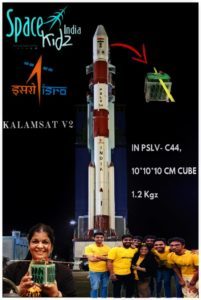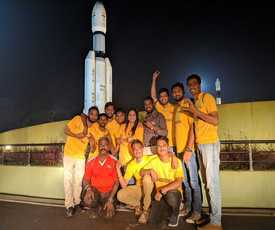[email protected]
Kalamsat-V2, a proud moment for Indians and aspires children to explore the world of science
India’s Polar Satellite Launch Vehicle (PSLV-C44) successfully injected Microsat-R and Kalamsat-V2 satellites into their designated orbits. Indian Space Research Organisation (ISRO) launched PSLV-C44 along with Microsat-R and Kalamsat-V2 on January 24, 2019 from the First Launch Pad at Satish Dhawan Space Centre SHAR, Sriharikota.
What was special about this launch? Firstly, PSLV-C44 mission was unique as it was for the first time ISRO used the fourth stage (PS4) or last stage of the rocket as a platform to perform experiments in space. At the fourth stage (PS4), the vehicle was moved to a higher circular orbit of 453 km after two restarts of the stage, to establish an orbital platform for carrying out experiments.
 Secondly, Kalamsat-V2, build by students and Space Kidz India, is the first student satellite to use (fourth stage) PS4 as an orbital platform. Kalamsat-V2, world’s lightest satellite, was taken to its designated orbit about 1 hour and 40 minutes after lift-off. The launch of Kalamsat-V2 is a proud moment for Indians, especially for students’ community which will definitely provide hopes and impetus for aspiring students to explore and build more such satellites. Talking to News4children, Mohammed Abdul Kashif, Lead Engineer of Kalamsat V2, Space Kidz India shares about Kalamsat V2.
Secondly, Kalamsat-V2, build by students and Space Kidz India, is the first student satellite to use (fourth stage) PS4 as an orbital platform. Kalamsat-V2, world’s lightest satellite, was taken to its designated orbit about 1 hour and 40 minutes after lift-off. The launch of Kalamsat-V2 is a proud moment for Indians, especially for students’ community which will definitely provide hopes and impetus for aspiring students to explore and build more such satellites. Talking to News4children, Mohammed Abdul Kashif, Lead Engineer of Kalamsat V2, Space Kidz India shares about Kalamsat V2.
What were the challenges faced while developing Kalamsat V2? How long did you take to build it?
We were researching on this for nearly 5-6 years now. Theoretically, we were completely aware of what to be done. The main challenge was we just had 6 days when we got green signal from ISRO to send it for testing. Satellites build by students have been launched earlier. But this is the first satellite build by students, to use the last stage as an orbital platform.
What is the age group of students and team members name?
The age group of students who were part of the project is between 19 to 21 years. Below are the names of the team members
 Dr Srimathy Kesan- Mission Director
Dr Srimathy Kesan- Mission Director
Mr Rifath Sharook- Lead Scientist
Mr Mohammed Adbul Kashif – Lead Engineer
Mr Yagna Sai –Lead Technician
My Vinay Bharadwaj –Design Engineer
Mr Tanishq Dwivedi – Flight Engineer
Mr T Gobinath Biologist
Mr Vijaya Lakshmi Narayan S – Lead Satellite Architect
What is the difference between Kalamsat launched by NASA and Kalamsat-V2?
Yes, Kalamsat was launched by NASA in June 2017. It just entered the space, and that would not orbit around the Earth. Whereas the Kalamsat-V2 is a complete orbital mission and will stay in the orbit forever. The life expectancy is 2 months, that is the electronic parts may die, but it will stay in the orbit forever.
What is the function of Kalamsat –V2?
It is a communication satellite. Now what we have launched is just a technology demonstrator and has no commercial use. The architecture or the design structure of the satellite is economical. In the future, the same architecture can be used to build a satellite that can be used for communication, especially it will be useful for warning disaster management.
How was ISRO supportive in this mission?
ISRO has student research projects and it is free of cost to put up the satellite to be launched. We put up Kalamsat-V2 through this project. In India students lack the practical experience and ISRO is now trying to help the student community. Students can approach ISRO and make use of the opportunities provided.
How can aspiring students get involved ?
Space Kidz India is always willing to help and provide the practical exposure to the students’ community. We conduct annually the ‘Young Scientist India’ and students can participate and showcase their ideas. Good ideas are picked and we will provide platform to students to get involved.
Further we are also planning to organise workshops for students to learn more. This is still in the pipeline.
Space Kidz India is based in Chennai. Are you planning to branch out in Bangalore?
Yes, we are getting many requests for the same. We are planning and may be in the near future we will.
Few facts about Kalamsat V2
- Kalamsat v2 is a 10 cm cube satellite weighing 1200 grams, is the world’s lightest satellite
- It uses a modified new kind of electronic systems and buses which makes use of commercially off the shelf components to make the space exploration easier and economical.
- Kalamsat will be the first-ever satellite to use this demonstration of spent stage PS4 (fourth stage) as the orbital platform and do research. It will reduce the cost of space exploration and launch and also reduce the development of space debris.

